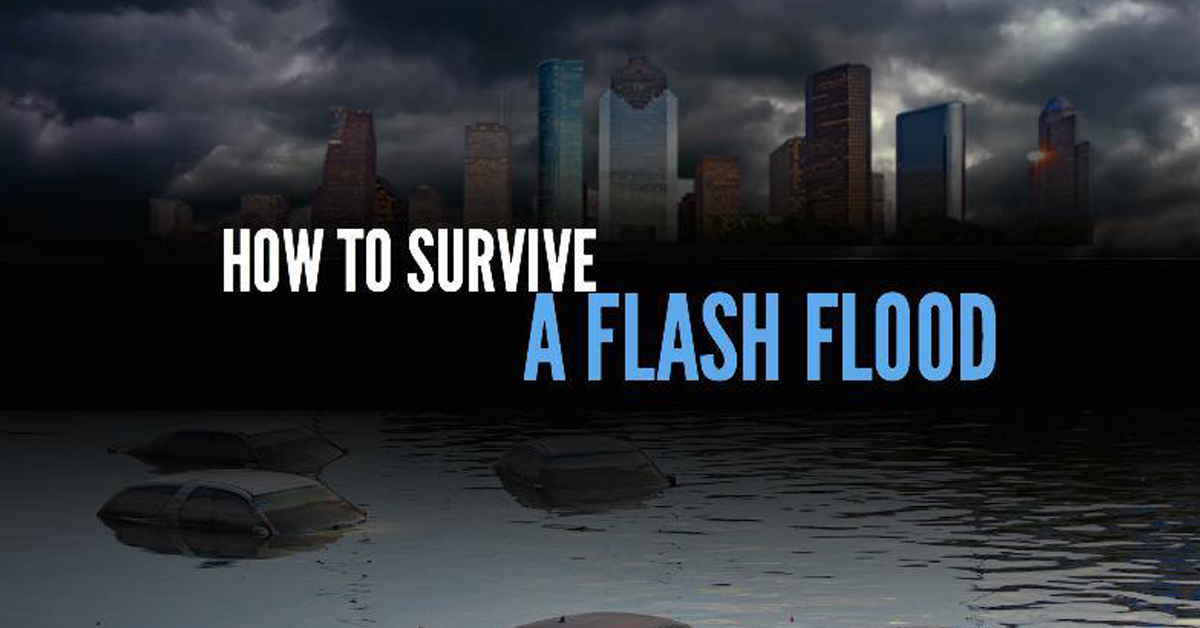How To Survive A Flash Flood Emergency: A Practical Guide

Table of Contents
Understanding Flash Flood Risks and Warnings
Understanding your risk and knowing how to recognize warnings are crucial for flash flood survival.
Identifying High-Risk Areas
Flash flood prone areas are often characterized by steep slopes, canyons, and areas with poor drainage. Recent heavy rainfall significantly increases the risk. Locations near mountains or dry riverbeds are especially vulnerable. Knowing your surroundings and identifying potential hazards is a key step in flash flood preparedness.
- Examples of high-risk areas: Mountainous regions, areas with recent wildfires (burned soil doesn't absorb water well), areas near rapidly flowing rivers or streams, urban areas with inadequate drainage systems.
- Signs of potential flash flooding: Rapidly rising water levels in streams and rivers, overflowing streams or creeks, muddy water appearing in normally dry areas, a sudden increase in water flow. A flash flood risk assessment for your specific area can provide further insights.
Recognizing Warning Signs and Alerts
Staying informed about weather forecasts is critical. Pay close attention to official warnings issued by your local meteorological service and emergency management agencies.
- Different types of alerts: Flash Flood Watches (conditions are favorable for flash flooding), Flash Flood Warnings (flash flooding is occurring or is imminent), Emergency Alerts (via mobile phones and other systems).
- How to sign up for emergency alerts: Register with your local emergency management agency's website; enable emergency alerts on your smartphone.
- What to do when you hear a warning: Immediately implement your emergency plan (details below), evacuate if instructed, and stay informed about the evolving situation. Understanding the severity of the flash flood warnings is vital for your safety.
Creating a Flash Flood Emergency Plan
A well-defined plan is your first line of defense against a flash flood emergency.
Developing a Family Communication Plan
In a flash flood, communication can be disrupted. Having a plan ensures everyone knows where to meet and how to contact each other.
- Steps for creating a communication plan: Identify a designated out-of-area contact person (someone outside the affected area), choose multiple meeting points (one close to home, one further away), and establish a communication schedule (e.g., check-ins at specific times).
- Out-of-state contact person: This person acts as a central hub for communication in case family members are separated.
Assembling an Emergency Kit
A flash flood survival kit contains essential items to sustain you until help arrives.
- List of essential items:
- Water (at least one gallon per person per day for several days)
- Non-perishable food (easy-to-prepare items)
- First-aid kit (including any necessary medications)
- Flashlight and extra batteries
- Weather radio (with extra batteries)
- Whistle to signal for help
- Dust mask to filter contaminated air
- Plastic sheeting and duct tape to shelter from rain
- Copies of important documents (in a waterproof bag)
- This flash flood survival kit should be easily accessible and regularly checked.
Actions to Take During a Flash Flood Emergency
Swift action is crucial when a flash flood occurs.
Immediate Actions
If you are caught in a flash flood, your immediate priority is to get to higher ground.
- Detailed steps to take if caught in a flash flood: Move to higher ground immediately, avoid walking or driving through floodwaters (even shallow water can sweep you away), stay away from power lines and downed trees, monitor rising water levels.
- Being prepared and knowing your flash flood safety tips could be the deciding factor in your safety.
If Trapped in a Vehicle
Never attempt to drive through floodwaters. The depth can be deceptive, and your vehicle can be quickly swept away.
- Steps to escape a flooded vehicle safely: If your vehicle is caught in rising floodwaters, immediately abandon it and seek higher ground. If possible, open the windows and climb out, moving quickly to higher ground.
- Never underestimate the power of floodwaters and the dangers of driving through flooded areas, learn about flooded car safety for such scenarios.
Post-Flash Flood Actions & Recovery
Even after the immediate danger has passed, there are still significant risks and important recovery steps.
Safety Precautions After the Flood
Floodwaters often contain contaminants and debris, posing health and safety risks.
- Safety measures to take after the flood recedes: Avoid contact with floodwater (it may be contaminated), be cautious of downed power lines, inspect your home for structural damage before re-entering, watch out for unstable structures.
Seeking Assistance and Reporting Damage
Many resources are available to help with flood relief and recovery.
- List of resources: Contact your local emergency management agency, FEMA (Federal Emergency Management Agency), and your insurance company. Many charities also offer assistance.
- Process for reporting damages: Report any damages to your insurance company and to your local government for potential assistance programs. Understanding post-flood safety and disaster assistance are vital for recovery.
Conclusion
Being prepared for a flash flood emergency is crucial for your safety and the safety of your loved ones. This guide highlights the importance of understanding flash flood risks, creating a comprehensive emergency plan, and taking swift action during and after a flash flood. Don't wait for a flash flood to hit. Take proactive steps today by creating your family's flash flood emergency plan and sharing this guide with your loved ones. Being prepared for a flash flood emergency can save lives.

Featured Posts
-
 Comprendre Les Gens D Ici Un Guide Pratique
May 26, 2025
Comprendre Les Gens D Ici Un Guide Pratique
May 26, 2025 -
 Escape The Everyday Find Tranquility At This Andalusian Farmstay
May 26, 2025
Escape The Everyday Find Tranquility At This Andalusian Farmstay
May 26, 2025 -
 Quel Avenir Pour Les Anciens Locaux De La Rtbf Au Palais Des Congres De Liege
May 26, 2025
Quel Avenir Pour Les Anciens Locaux De La Rtbf Au Palais Des Congres De Liege
May 26, 2025 -
 Local News Triumph Myrtle Beach Newspaper Wins 59 Sc Press Association Awards
May 26, 2025
Local News Triumph Myrtle Beach Newspaper Wins 59 Sc Press Association Awards
May 26, 2025 -
 The Casting Of Robert Downey Jr In Jamie Foxxs All Star Weekend A Discussion
May 26, 2025
The Casting Of Robert Downey Jr In Jamie Foxxs All Star Weekend A Discussion
May 26, 2025
